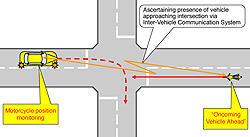
Some fascinating food for thought over at Honda. Its ASV-3 project (Advanced Safety Vehicles, version 3) aims to do for cars what the internet did for computers.
Although ASV-3 is a wide-ranging safety project, tackling problems such as how to improve the visibility of motorcycles, its most far-reaching avenue of investigation centres on giving vehicles the ability to communicate with each other.
Imagine, for example, that a rock-fall has partially blocked a tight corner, and the next car to approach the spot has to take evasive action. The ASV-3 system in that car could note the emergency manoeuvre and, using conventional satellite navigation, attach a warning to that part of the map. Other cars networked into the same system would then be forewarned if their own navigation systems predict that they might encounter the newly-identified danger zone.
Clearly this kind of data could be centrally pooled and then broadcast, using an efficient publish-and-subscribe architecture.
Equally, Honda suggests that there is merit in allowing cars to communicate wirelessly with each other directly, on a peer-to-peer or mesh network basis, as the cars most likely to be affected are of course already in the immediate vicinity of the trouble spot.
Another scenario aims to alert drivers if two vehicles appear to have convergent intentions. In the example pictured, a motorcycle is heading straight through an intersection, while a car is travelling in the opposite direction towards the junction but has activated its indicators, suggesting it plans to cross the carriageway in front of the bike. Using the Honda system, the two vehicles would communicate and the system might give warnings to both rider and driver of the impending danger.
Clearly Honda’s vision works only if all communicating vehicles have satellite navigation systems and up-to-date maps. And of course it suffers or benefits from the network effect – the value of the system greatly depends on how many others also participate, making it hard to get off the ground.
Government legislation would probably be required, but the potential benefits look very great indeed.
Honda plans web for cars
5 September 2005



